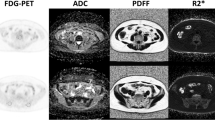Abstract
Purpose
This study evaluated the usefulness of 3-Tesla magnetic resonance (MR) spectroscopy in patients with non-Hodgkin’s lymphoma (NHL) undergoing bone marrow transplantation (BMT).
Materials and methods
Twelve NHL patients who were candidates for BMT underwent three MR examinations of the lumbosacral spine: before ablative therapy for BMT, 15±4 days and 54±24 days after BMT. The MR study was supplemented by spectroscopic analysis. The lipid content was calculated and expressed as a percentage of lipid signal intensity relative to total signal intensity [fat fraction (FF)].
Results
In the first MR study, the FF was 62.5±7%, in the second it was 70.75±5% and in the third it was 75±1%. We observed a statistically significant difference between FF values calculated at the various MR studies (p=0.02) and between red blood cell count (p=0.017), platelet count (p=0.003) and haematocrit (p<0.001) at the three MR studies. FF had a statistically significant correlation with the number of circulating platelets (p<0.01)
Conclusions
MR spectroscopy of the bone marrow of NHL patients undergoing BMT is noninvasive and highly sensitive for characterising and monitoring bone marrow after BMT.
Riassunto
Obiettivo
Scopo del presente lavoro è stato valutare l’utilità della spettroscopia mediante risonanza magnetica (RM) a 3 tesla nei pazienti affetti da linfoma non-Hodgkin (LNH) sottoposti a trapianto di midollo osseo (TMO).
Materiali e metodi
Dodici pazienti affetti da LNH candidati al TMO sono stati sottoposti a 3 esami RM del rachide lombo-sacrale: prima della terapia ablativa per il TMO, dopo 15±4 giorni dal TMO e dopo 54±24 giorni. Lo studio RM è stato integrato con analisi spettroscopica. è stato calcolato il contenuto di lipidi, espresso in percentuale come intensità di segnale relativa dei lipidi rispetto all’intensità di segnale totale (fat fraction, FF).
Risultati
Nel primo studio RM si riscontrava una FF=62,5%±7%; nel secondo una FF=70,75%±5%; nel terzo una FF=75%±1%. Abbiamo osservato una differenza statisticamente significativa tra i valori di FF calcolati ai vari controlli RM (p=0,02), tra il numero dei globuli rossi (p=0,017), delle piastrine (p=0,003) e tra i valori dell’ematocrito (p<0,001) tra i tre controlli RM. La FF presenta una correlazione statisticamente significativa con il numero delle piastrine circolanti (p<0,01).
Conclusioni
La RM con studio spettroscopico del midollo osseo su pazienti con LNH sottoposti a TMO rappresenta una metodica non invasiva e molto sensibile nella caratterizzazione e monitoraggio del midollo osseo dopo TMO.
Similar content being viewed by others
References/Bibliografia
Zinzani PL, Martelli M, Poletti V et al (2008) Practice guidelines for the management of extranodal non-Hodgkin’s lymphomas of adult non-immunodeficient patients. Part I: primary lung and mediastinal lymphomas. A project of the Italian Society of Hematology, the Italian Society of Experimental Hematology and the Italian Group for Bone Marrow Transplantation. Haematologica 93:1364–1371
Barosi G, Carella A, Lazzarino M et al (2006) Management of nodal diffuse large B-cell lymphomas: practice guidelines from the Italian Society of Hematology, the Italian Society of Experimental Hematology and the Italian Group for Bone Marrow Transplantation. Haematologica 91:96–103
Barosi G, Carella A, Lazzarino M et al (2005) Management of nodal indolent (non marginal-zone) non-Hodgkin’s lymphomas: practice guidelines from the Italian Society of Hematology, Italian Society of Experimental Hematology and Italian Group for Bone Marrow Transplantation. Haematologica 90:1236–1257
Bierman PJ, Phillips GL (2009) Role of hematopoietic stem cell transplantation in the treatment of non-Hodgkin’s lymphoma. Cancer Treat Res 144:1–41
Steingass SK (2006) Hematopoietic stem cell transplantation in non-Hodgkin’s lymphomas. Seminars in Oncology Nursing 22:107–116
Schick F, Einsele H, Weiss B et al (1996) Assessment of the composition of bone marrow prior to and following autologous BMT and PBSCT by magnetic resonance. Ann Hematol 72:361–370
Chabanova E, Johnsen HE, Knudsen LM et al (2006) Magnetic resonance investigation of bone marrow following priming and stem cell mobilization. J Magn Reson Imaging 24:1364–1370
Bland JM, Altman DG (1986) Statistical methods for assessing agreement between two methods of clinical measurement. Lancet I:307–310
Lin LI-K (1989) A concordance correlation coefficient to evaluate reproducibility. Biometrics 45:255–268
Lin LI-K (2000) A note on the concordance correlation coefficient. Biometrics 56:324–325
Ambrus CM, Ambrus JL (1975) Myeloid regeneration after whole body irradiation, autologous bone marrow transplantation, and treatment with an anabolic steroid. J Med 6:27–32
Crouch MA, Ross JA (1994) Current concepts in autologous bone marrow transplantation. Semin Oncol Nurs 10:12–19
Gribben JG, Nadler LM (1993) Bone marrow purging for autologous bone marrow transplantation. Leuk Lymphoma 11(Suppl 2):141–148
Roberts N, Smith SR, Percy DF et al (1991) The quantitative study of lumbar vertebral bone marrow using T1 mapping and image analysis techniques: methodology and preliminary results. Br J Radiol 64:673–678
Guglielmi G, Biccari N, Mangano F et al (2010) 3 T magnetic resonance imaging of the musculoskeletal system. Radiol Med 115:571–584
Schick F, Einsele H, Weiss B et al (1995) Characterization of bone marrow after transplantation by means of magnetic resonance. Ann Hematol 70:3–13
Fanucci E, Manenti G, Masala S et al (2007) Multiparameter characterization of vertebral osteoporosis with 3-T MR. Radiol Med 112:208–223
Machann J, Stefan N, Schick F (2008) (1)H MR spectroscopy of skeletal muscle, liver and bone marrow. Eur J Radiol 67:275–284
Shen J, Griffith JF, Cheng LN et al (2008) Bone marrow MR imaging as predictors of outcome in hemopoietic stem cell transplantation. Eur Radiol 18:1884–1891
Author information
Authors and Affiliations
Corresponding author
Rights and permissions
About this article
Cite this article
Sergiacomi, G., Gaspari, E., Taglieri, A. et al. 3-Tesla MR spectroscopy in patients subjected to bone marrow transplantation: clinical correlations. Radiol med 118, 101–111 (2013). https://doi.org/10.1007/s11547-012-0796-8
Received:
Accepted:
Published:
Issue Date:
DOI: https://doi.org/10.1007/s11547-012-0796-8




